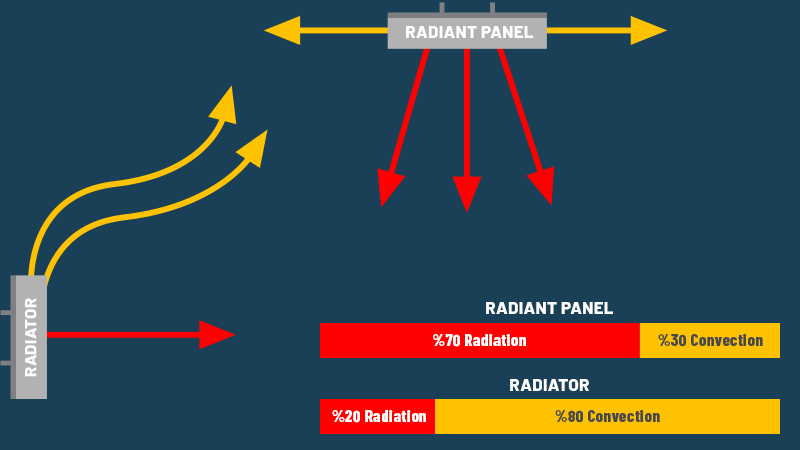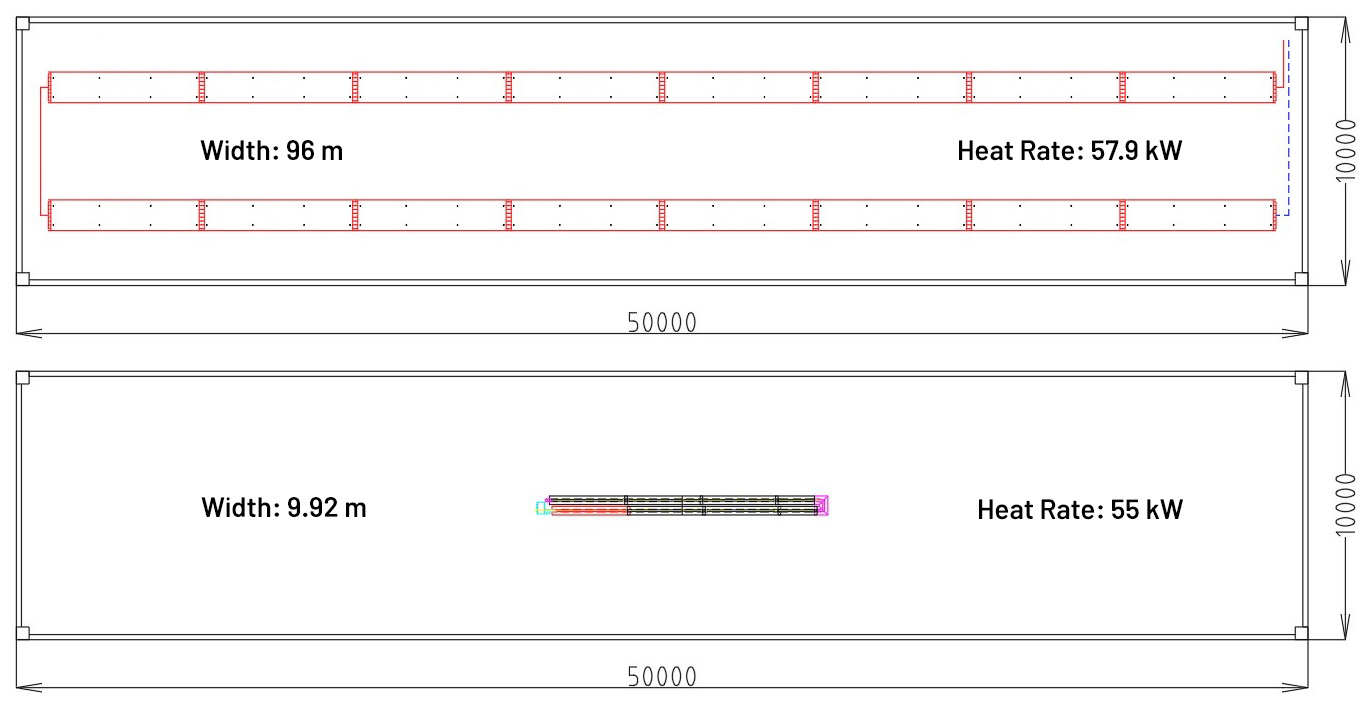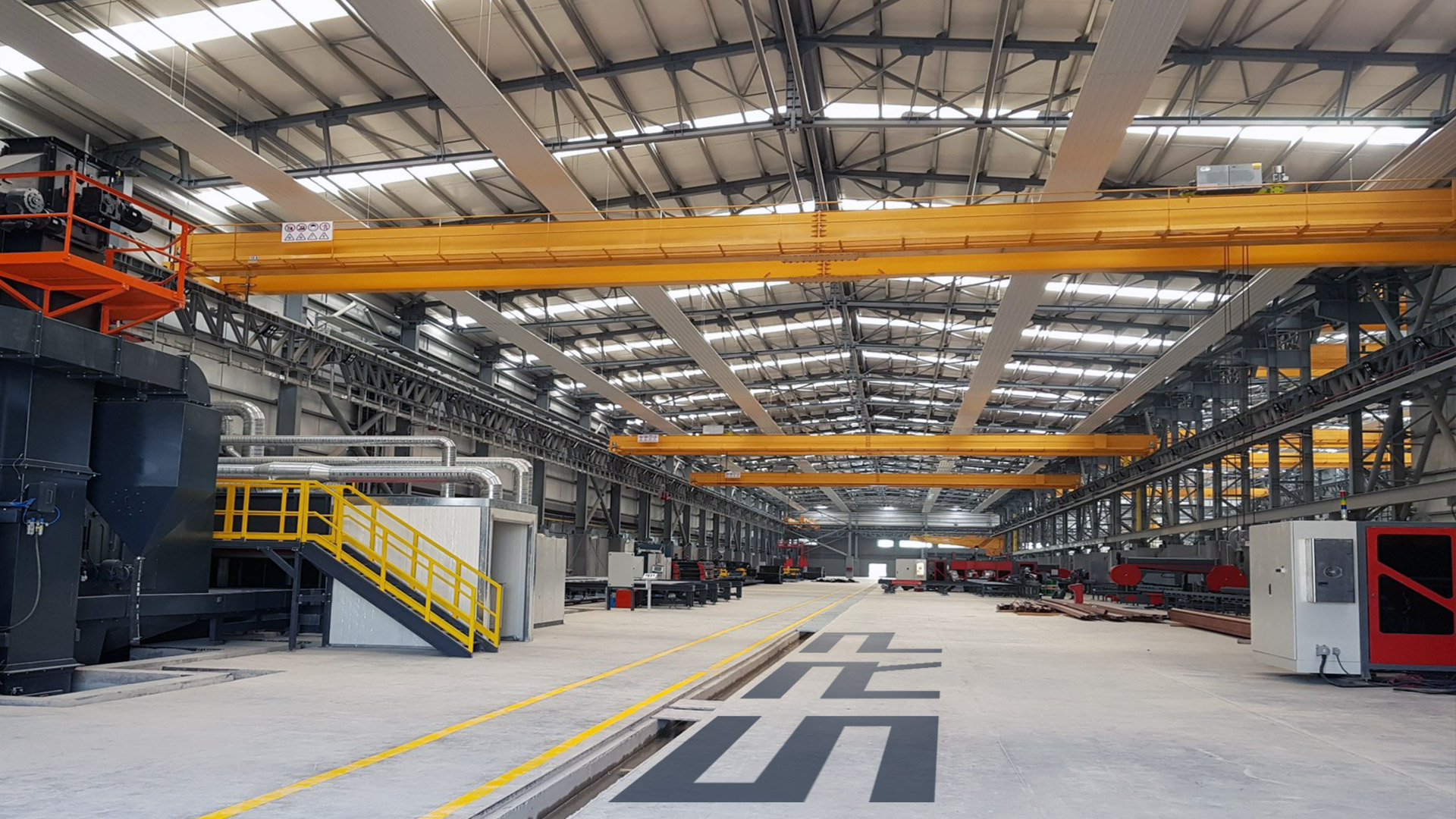F.A.Q.
Frequently Asked Questions;
1. Water Radiant is a very new system, we've never heard of it before, wouldn't we have a problem?
Water Radiant heating is not a new technology. Even 60 years ago, Water Radiant heating was used. The reason why this technology is considered to be new is due to the recent spread of Water Radiant panels due to the increasing demand for energy efficiency and comfort. A great comfort and satisfaction is experienced in all of our Water Radiant projects that we have completed in our country. Therefore, there will be no problems.
2. It looks a lot like a radiator, isn't it the same?
While radiators transfer 80% of their heat by convection, they transfer only 20% by radiation. Therefore, it is not correct to call radiators radiant heaters.

3. If we connect the radiator to the ceiling, wouldn't it work the same way?
Unlike radiators, which primarily heat the air in the environment, Water Radiant panels primarily heat the objects in their area of influence through radiation. While radiators are designed to transfer heat through convection, that is, air movement, Water Radiant panels are designed to keep convection to a minimum. Therefore, Water Radiant panels cannot be considered as ceiling-suspended radiators.
4. The heated air rises, so isn't underfloor heating a better solution than the Water Radiant heating system?
Underfloor heating, like radiators, is a convective heating system. Therefore, in this system, it is essential to heat the ambient air. In the construction of convective systems, the rise of the heated air due to the decrease in its density is taken into account. However, Water Radiant panels perform heat transfer through radiation (radiation). Heat transferred by radiation can radiate in the direction its source points, including downwards. Radiation allows the objects in the direct impact area to be heated without heating the ambient air.
The best example of this is the radiant heat of the sun reaching the earth after traveling more than 90 million miles and warms the earth. In addition, Water Radiant heating systems are more efficient as they are not affected by high resistance floor coverings and in dusty environments, they can provide more comfortable heating since they do not move the particles that can rise with the air.
5. Doesn't heating the environment with devices that carry out heating process by blowing such as unit heater or fancoil, provide more comfort than Water Radiant heating, which heats the objects it sees?
In order to provide comfortable heating, it is not necessary to heat the large air mass in which people or objects are located. On the contrary, Water Radiant heating creates a more natural warming feeling as it is a small simulation of the heating of the sun. In addition, heating the air can lead to additional energy consumption and discomfort in many cases. In buildings with high ceilings, the areas that are undesirable to be heated (under-ceiling area) reach higher temperatures due to the thermal stratification effect, while the area to be heated (working area) remains at lower temperatures.
While this situation creates discomfort in heating, it also increases the temperature of the areas that are not wanted to be heated, increases heat losses and leads to energy wastage. Another disadvantage of air heating is that due to the density difference of the heated air, it clusters at the leak points (doors, windows, etc.) in the space and creates an inhomogeneous heat distribution. This again causes discomfort and additional energy consumption. In blown systems, there is a continuous air movement and noise in the environment. Since air movement will cause especially particle and dust movement, it impairs the quality of the ambient air and may create an unhealthy environment. However, if the blowing temperature drops below a certain value in blown heating, even if the blown air temperature is above the ambient temperature, it may create a feeling of cooling instead of warming.
This causes the leaving water temperature of the heat generator not to be lowered below a certain value, even if it is not needed. And therefore, it causes low efficiency and high energy consumption. None of these disadvantages mentioned for blown heating apply to Water Radiant panels.
6. Since the heating is done from the ceiling in Water Radiant panels, will there be consequences such as overheating our head and causing us discomfort?

If the Water Radiant panel design and installation is done correctly, such a situation does not occur. The system design is made by considering the area of influence, the required thermal capacity and water temperature values depending on the hanging height of the panels. Unlike tube or ceramic radiant heaters, the surface temperatures of Water Radiant panels can be controlled depending on the water temperature. And since the area of influence for the unit thermal capacity is much higher thanks to its large surface area, if the system is designed correctly, there is no possibility of discomfort as a result of overheating.
7. Will hanging Water Radiant Heating Panels on the ceiling create an ugly appearance in the environment?
Water Radiant panels reduce the amount of piping in the space compared to their alternatives, rather than creating an ugly appearance. And since there is no need for any chimney or additional ventilation, it takes up little space and provides a monolithic appearance thanks to its intermediate covers, it provides a very elegant and simple appearance.

8. Why should I choose Water Radiant Panels over Tube Radiant Heaters?
By visiting theCOMPARISONSlink, you can examine in detail the “Advantages of Water Radiant Heating System Compared to Tube Radiant Heating Systems” section.
9. Why should I choose Water Radiant Panels over Ceramic Radiant Heaters?
You can view the COMPARISONS link in detail in the “Advantages of Water Radiant Heating System Compared to Ceramic Radiant Heating Systems” section.
10. Why should I choose Water Radiant Panels over Unit Heaters?
You can view the COMPARISONS link in detail in the “Advantages of Water Radiant Heating System Compared to Convection Heating Systems” section.
11. Will Water Radiant Panels harm bridge cranes? Is a heat shield necessary?
One of the biggest advantages of Water Radiant panels over gas radiants is that their surface temperatures are low. Since the surface temperatures are low, it does not cause any damage to the bridge cranes, there is no need for a heat shield.
12. What happens if we hang Water Radiant panels at an angle?
It is possible to hang Water Radiant panels at an angle, there will be no change in thermal power. However, if the panels are hung at an angle, the convectional losses will increase and the radiant efficiency of the panels will decrease. Therefore, it is not possible to say that it will fully serve its purpose.
13. Can we use Water Radiant panels outdoors and in cafes?
Water Radiant panels are more suitable for comfortable heating of the entire area rather than point heating. Considering the need for large surface area, although it is possible to use Water Radiant panels in open areas and cafes, it is not a logical solution.
14. Is it possible to disassemble and install Water Radiant panels?
Removing and installing Water Radiant panels is directly related to the connection method. Panels connected with pressfittings can be disassembled and reassembled, but difficult. However, if the threaded connection option is evaluated, the panels can be easily disassembled and mounted.
15. In how many hours do Water Radiant panels bring the interior to the desired temperature?
The time for the environment to enter the regime is directly related to the thermal losses at the time the system is activated, the size of the space and the heater thermal capacity. Therefore, reaching the desired temperature of the environment is evaluated independently of the heating system and can only be calculated for the time period determined specifically for the project.
16. Can we heat Water Radiant panels with solar energy?
Theoretically, it is possible to heat Water Radiant panels with any heat source, including solar energy. However, if it is necessary to make an evaluation in terms of solar energy, it can be said that the period in which the maximum efficiency will be obtained from solar energy will be the summer period, and the period in which the minimum efficiency will be obtained will be the winter period. When it is considered that the winter period will be the period when the heating need will be most intense, it is difficult to say that the solar energy investment is a suitable investment for heating in general.
17. How many degrees of water can we heat in Water Radiant panels?
Theoretically, if there is a temperature difference, even if it is very small, between two surfaces, it can be said that heat can be transferred between these surfaces by radiation from the surface with a higher temperature to the surface with a lower temperature. Therefore, it is possible to heat even by sending water around 40 C to the Water Radiant panels. However, since using these temperature values as the design value will increase the surface area of the Water Radiant panel too much, it is recommended to use such low temperatures in the transition seasons, that is, in the periods when the thermal losses are relatively low, and the design should be made according to higher temperature values.
18. What is the degree of the water fed to the Water Radiant panels be?
Water Radiant panels can be used at water temperatures between 40 °C and 110 °C.
19. Are Water Radiant panels suitable for automation? Is there a remote access option?
Water Radiant panels can be controlled locally by means of two-way or three-way motorized valves and thermostats, as well as by a central automation system. Depending on the nature of the automation system and thermostats, a remote access option may also be provided.
20. Why are Water Radiant panels more efficient than other systems?
The thermal efficiency of a radiant system is the sum of the combustion efficiency, thermal efficiency, radiant efficiency, control efficiency, and design efficiency. The main factors that make Water Radiant panels more efficient than alternative systems are combustion efficiency, radiant efficiency and control efficiency. Contrary to alternative systems, Water Radiant panels can operate at very low water temperatures, so the condensation efficiency can be utilized to the maximum, and therefore the combustion efficiency of Water Radiant panels is considerably higher than alternative systems. Radiant efficiency is the value that expresses the rate at which the transferred heat is transferred by radiation. Since convectional losses are minimal in Water Radiant panels, radiant efficiency is much higher than alternative systems.
Since both temperature and flow rate control can be achieved with a correct automation setup in Water Radiant panels, the desired temperature can be kept stable by providing the exactly required heat. This provides an extra efficiency advantage compared to alternative heating systems that operate predominantly in stages. You can examine the detailed comparison of Water Radiant panels with alternative systems on the COMPARISONS page.
21. Can I use Water Radiant panels with the old boiler room? Can I replace existing Unit Heaters with Water Radiant?
Water Radiant panels can be used with existing boiler rooms, provided that the boiler, pump and expansion tank capacities are checked. Depending on the unit heater placements, pipe diameters and panel design, it is possible to use the existing unit heater installations for the feeding of Water Radiant panels.
22. Is the radiation in radiant systems harmful to human health?
For Water Radiant heating systems, the effective range of radiation is limited to the wavelength range of infrared rays. Infrared radiation is also called thermal radiation as our body perceives it as heat. Infrared radiation is a natural radiation that we can encounter every day in many different forms and has no harmful effects on human health.
23. Isn't there a serious energy loss in the piping between the boiler room and the radiants?
The energy loss in the piping between the boiler room and Water Radiant panels depends on many factors such as the route of the pipes, whether the pipe route is a heated or unheated area, the amount of insulation, ambient temperature and water temperature. If the pipes pass through the heated areas, the energy transferred from the pipes to the area in these areas is not considered as a loss. If the pipes pass through the outside or unheated areas, there will be a loss of energy, but it is possible to keep the energy losses at a negligible level with properly insulated pipes and correctly designed routes.
24. What should the indoor temperature be?
Optimum indoor temperatures vary according to the location, line of business and physical activities of employees. The minimum and comfort temperatures table according to the location and activity prepared by Rehva on this subject can be a guide for the design.
The minimum and comfort operating temperatures for different activity levels are given in the table below.
| HUMAN ACTIVITY, AREA | min. WORKING TEMPERATURE (°C) | COMFORT WORKING TEMPERATURE (°C) |
| Resting state | 19 | 22-24 |
| Very light physical activity (knitting, sawing, typesetting, sewing and drawing workshops, etc.) | 18 | 20-22 |
| Light physical activity (tool-machine manufacturing, welding shop and kitchen workers, etc.) | 16 | 18-20 |
| Moderate physical activity (iron-casting workshops, rolling mills and machine tool workers, etc.) | 14 | 16-18 |
| Heavy physical activity (workers in carpentry, earthmoving and shoveling workshops, etc.) | 10-12 | 14-16 |
| Living areas, offices | 19 | 22-24 |
| Classrooms, dining halls | 18 | 20-22 |
| Meeting rooms | 16-18 | 18-22 |
| Gyms, playgrounds | 10-12 | 14-16 |
| Conference rooms | 15-16 | 18-20 |
25. Can pipes in Water Radiant panels become clogged? Can pipes rot and puncture?
If the water conditions we recommend are provided for our Water Radiant panels to work with optimum efficiency and longevity and if the necessary strainer, dirt separator and similar equipment in the installation are used correctly and maintained regularly, the risks of clogging, rot and perforation are negligible in our applications. The average lifetime of our Water Radiant panels is 50 years.
26. Could there be a water leak in the system?
Unless there is a special situation in our applications, we prefer the pressfittings application. Therefore, the risk of water leakage is minimal.
27. Is there a need for ventilation in Water Radiant panels?
As with ceramic plate radiant heaters, the need for ventilation due to the release of waste gases to the environment is not prevalent in Water Radiant panels. In order to ensure that the comfortable ventilation required for the area does not impose an additional burden on the heating system or to ensure a higher efficiency operation by keeping the future load to a minimum, we recommend that the ventilation need be provided with heat recovery ventilation units.
28. Does the efficiency decrease when the panel surface is dirty?
Water Radiant panels do not work with the logic of directing the heat through a reflector as in other radiant heaters. For this reason, the efficiency reduction caused by pollution is much lower and negligible compared to other radiant heaters. However, it is recommended to clean the panel surfaces at regular intervals in order for the system to work most efficiently in heavily polluted environments.
29. Is there a minimum and maximum height limit for Water Radiant applications?
Water Radiant panels can be applied from 2.5 m to 40 m height, considering temperature differences and heater surface areas. The relationship between minimum hanging heights, panel widths and temperature differences can be examined in the table below.
| TEMPERATURE DIFFERENCE DT |
PANEL WIDTH / HANGING HEIGHTS | ||||
| 300mm | 600mm | 900mm | 1200mm | 1500mm | |
| 70K | 2,20m | 2,60m | 3,00m | 3,40m | 3,70m |
| 60K | 2,10m | 2,40m | 2,70m | 3,00m | 3,30m |
| 50K | 2,10m | 2,30m | 2,50m | 2,70m | 2,90m |
| 40K | 2,00m | 2,10m | 2,20m | 2,40m | 2,50m |
DT = ((Flow Temperature + Return Water Temperature) / 2) – Indoor Temperature.
